Arthritis can be a debilitating condition, causing pain and limiting mobility for millions of people worldwide. But what if there was a way to alleviate some of the discomfort and improve joint function? This is where massage therapy comes in, offering a range of potential benefits for arthritis patients. Do massages help Arthritis? The answer is yes, as they can provide pain relief, enhanced joint mobility, and an overall improvement in quality of life. Join us as we delve into the science behind massage therapy for Arthritis and explore various types of massages, therapist selection, self-massage techniques, and necessary precautions.
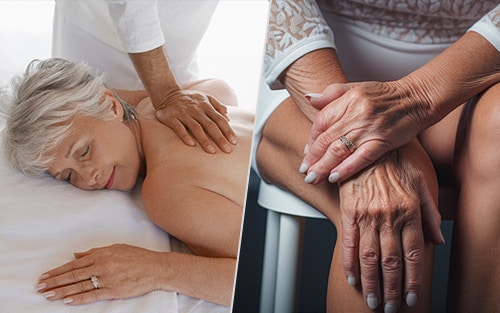
Key Takeaways
- Massage therapy has been proven to reduce pain, improve joint mobility, and enhance the quality of life for people living with Arthritis.
- Various massage techniques offer beneficial relief for arthritis symptoms, such as Swedish, deep tissue, and hot stone.
- Self-massage can be an effective way to manage pain when using moderate pressure and gentle techniques. It is important to consult with a healthcare professional before beginning treatment.
Scientific Research – Is Massage Therapy Good for Arthritis
In this section, we will delve into the scientific research surrounding the effectiveness of massage therapy for Arthritis and answer the question, is massage good for Arthritis? We will explore the mechanisms behind how massage therapy works to alleviate arthritis symptoms and improve joint function, supported by various studies and research findings. We aim to provide a comprehensive understanding of why massage therapy can benefit those suffering from Arthritis and osteoarthritis.
Massage for Arthritis in the Knee (Osteoarthritis)
Several studies on knee pain have documented decreased knee pain following massage therapy. Below are details on two specific studies.
Research conducted in 2018 and published in the Journal of General Internal Medicine divided 200 osteoarthritis (OA) patients with knee issues into three distinct treatment groups. The results showed that after eight weeks, those who underwent a one-hour full-body massage every week noticed a substantial improvement in their pain and mobility. This group outperformed the other groups who received light touch or standard care.

Another 2017 study in Oxford Academic’s Pain Medicine reported that participants noted an improved ability to perform daily living activities after experiencing massage therapy. Specifically, participants expressed “1) relaxation effects, 2) improved quality of life associated with receiving massage therapy, and 3) the accessibility of massage therapy in treating osteoarthritis.”
Hip Arthritis Massage Study
The Centers for Disease Control (CDC) reports approximately seven percent of U.S. adults experience hip pain. Many suffering from this condition ask if massage can help Arthritis. To address this inquiry, let’s delve into a study on whether massage therapy benefits hip arthritis patients.
The research study “Hip Pain is Reduced Following Moderate Pressure Massage Therapy” indicates the effectiveness of moderate pressure massage therapy for decreasing hip pain and sleep disturbances. Staff and faculty from a medical school experiencing hip pain were randomly divided into two groups: one that would receive moderate-pressure massage therapy and a control group that would be put on a waitlist. For one month, the massage therapy group received twenty-minute massages weekly.
On the first and last days of the treatment period and one month after, participants were asked to self-report their pain, stiffness, function, mood, sleep, and daily functioning. Pain was evaluated in terms of external rotation, internal rotation, and activities such as sitting, standing, and bending before and after the massage sessions on the first and last day.
Those in the massage group experienced an immediate reduction in pain following their sessions. Comparing the first and last day of the study, those who received massages reported a more significant decrease in pain across all measures and fewer sleep disturbances than the control group. These effects persisted even a month after the study concluded.
The Science Behind Massage Therapy and Arthritis
Massage therapy is a form of body manipulation that can potentially improve blood flow, loosen muscles around joints, reduce pain, improve mood, and increase range of motion, all of which can help decrease arthritis pain. There are two main types of Arthritis, osteoarthritis and rheumatoid Arthritis, and the primary indications of Arthritis are persistent joint pain and rigidity. While the exact mechanisms behind massage therapy’s pain-relieving effects on arthritis patients are still under investigation, it is believed to involve reducing stress and anxiety.
Through moderate pressure, massage therapy has been found to activate pressure receptors beneath the skin, sending signals to the brain that can reduce pain and stimulate the release of neurochemicals such as serotonin. This can help to reduce arthritis pain and relax tension.
This post will detail the specific benefits of massage therapy for pain relief, improved joint mobility, and enhanced quality of life in arthritis patients.
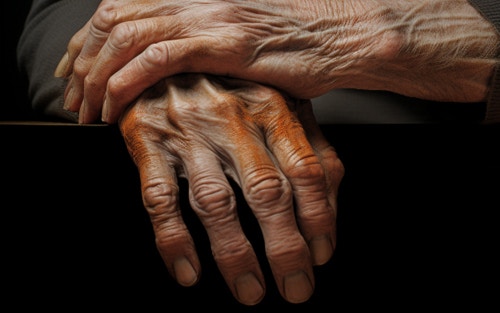
Pain Relief Mechanisms
The exact mechanisms of how massage therapy relieves pain in arthritis patients are still being explored. However, research suggests that moderate-pressure massage and myofascial release are effective in providing pain relief for rheumatoid Arthritis. It is believed that an increase in the brain’s serotonin output is responsible for the pain relief experienced by arthritis patients following massage therapy.
Serotonin plays a significant part in pain relief, blocking pain-related behaviors and modulating dopamine neurotransmission, enhancing serotonin expression, and reducing the release of substance P, which contributes to pain inhibition. Moreover, serotonin can modify serotonin synthesis and metabolism, promoting an overall increase in its tonic effects. These mechanisms combine to provide arthritis patients with pain relief, allowing them to experience decreased discomfort and an increased range of motion after moderate-pressure massage.
Joint Mobility Improvement
Massage therapy can be highly beneficial for arthritis patients regarding joint mobility improvement. Massage therapy aids in alleviating the pain and discomfort associated with Arthritis by reducing muscle tension and stiffness, promoting better circulation, and increasing the range of motion. Scientific studies demonstrate that massage therapy can improve joint mobility in arthritis patients, with some studies even indicating that massage therapy can help reduce pain and stiffness and improve function in patients with osteoarthritis and rheumatoid Arthritis.
One way massage therapy contributes to enhanced circulation and joint mobility is by applying pressure to the muscles and tissues, which encourages blood movement through congested areas and allows for the influx of fresh blood. Enhanced circulation is advantageous for joint mobility in arthritis patients, as it facilitates the delivery of oxygen and nutrients to the joints, reduces inflammation, and eliminates waste products.
Overall, massage therapy has been found to provide short-term improvements in arthritis symptoms and can be used to complement other treatments for Arthritis.
Quality of Life Enhancement
Studies have shown that various types of massage therapy can improve the quality of life for arthritis patients by reducing pain and fatigue and improving sleep. Massage therapy has been found to have specific benefits on fatigue in arthritis patients, such as reducing pain and anxiety, improving grip strength, increasing circulation, and improving range of motion and flexibility. Furthermore, massage therapy may temporarily improve the mobility of joints and muscles affected by Arthritis, although it does not reduce inflammation or joint damage.
In addition to its physical benefits, massage therapy can potentially improve sleep in individuals with Arthritis. The pressure in the massage can help release the muscles around the joints and increase blood flow, which can aid in reducing pain and stiffness associated with Arthritis. Furthermore, massage therapy may be beneficial in relaxing the muscles, improving joint mobility, and decreasing the production of pain-related neurotransmitters, thus leading to more restful sleep. As a result, incorporating massage therapy into an arthritis treatment plan can greatly enhance the overall quality of life for affected individuals.
Types of Massages for Arthritis Relief
Different types of massages can benefit arthritis patients, with each offering unique benefits and techniques. Massage therapies such as:
- Hot stone massage
- Deep tissue massage
- Sports massage
- Trigger point massage
- Myofascial release massage
Offer great solutions for arthritis relief. The subsequent sections will further examine the specific benefits and techniques of Swedish, deep tissue, hot stone, and myofascial release massages for arthritis patients.
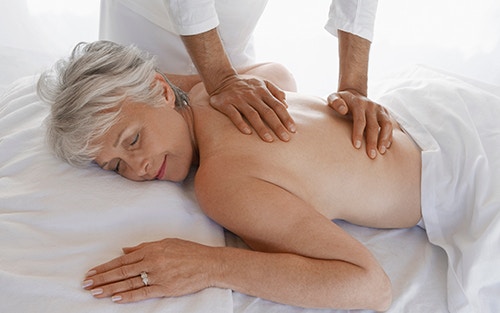
Understanding the various types of massages and their unique benefits enables arthritis patients to make informed decisions about the most effective massage therapy for their specific needs and preferences. This knowledge can help optimize the massage experience, improving symptom relief and overall well-being.
Swedish Massage
Swedish massage is a popular choice for arthritis patients, as it employs long, smooth strokes to decrease muscle rigidity and joint discomfort, increase circulation, and enhance joint range of motion. This type of massage is known for its gentle, relaxing techniques, making it an ideal option for those seeking relief from arthritis pain and stiffness.
Research has indicated that Swedish massage can be especially advantageous for those with osteoarthritis, helping to alleviate pain and improve overall joint function. Techniques used in Swedish massage for arthritis relief include long strokes, kneading, and rhythmic tapping, which work together to increase blood and lymph circulation without causing discomfort. This gentle approach makes Swedish massage a favorable option for many arthritis patients looking to improve their joint mobility and reduce pain.
Deep Tissue Massage
Deep tissue massage is another type of massage therapy that may benefit arthritis patients, as it targets the deeper layers of muscles and connective tissues with firm pressure. However, it’s important to note that deep tissue massage may not be suitable for those with active arthritis inflammation, as it can potentially cause further pain or damage.
If deep tissue massage is considered a treatment option for your Arthritis, consulting with a healthcare professional beforehand to ensure it is a safe and viable option for your specific condition and needs is advisable. When performed by a skilled therapist, deep-tissue massage can help alleviate muscle tension and relieve arthritis pain. Still, it is crucial to approach this type of massage with caution and awareness of any potential risks or limitations.
Hot Stone Massage
Hot stone massage is a therapeutic technique that utilizes heated stones strategically placed on areas of the back to promote relaxation of muscles and relief of tension. This type of massage has been found to:
- Improve blood flow
- Reduce inflammation in the joints
- Promote relaxation of muscles and tissues
- Provide pain relief to arthritis patients
In conjunction with Swedish massage therapy, hot stone massage can help alleviate muscle tension and lessen the severity of arthritis symptoms. It is essential to ensure the stones are not too hot. Excessively high temperatures can cause burns or scald scars. When performed correctly, a hot stone massage can be a soothing and effective option for arthritis patients seeking relief from joint pain and stiffness.
Myofascial Release
Myofascial release is a specialized technique that involves manipulating the connective tissues or fascia surrounding body structures such as blood vessels, nerves, and muscles. This type of massage therapy can help reduce pain and increase motion in arthritis patients, making it a valuable addition to an arthritis treatment plan.
To perform myofascial release, therapists use their hands, elbows, or knuckles to apply pressure and stretch the fascia tissues, helping to release tension and improve joint mobility. Myofascial release can be done with the assistance of a therapist or through the use of tools and devices at home. Some standard tools and devices used for myofascial release include:
- Foam rollers
- Massage balls
- Massage sticks
- Trigger point tools
These tools and devices offer a versatile and effective option for arthritis patients seeking relief from pain and stiffness.
Choosing the Right Massage Therapist
Finding the right massage therapist for arthritis patients is a crucial step in ensuring an effective and comfortable treatment experience. It is essential to seek referrals, check professional associations, and look for experience with arthritis patients to find a qualified therapist who can address your specific needs and preferences.

The subsequent sections will discuss:
- The importance of referrals and professional associations
- The value of experience with arthritis patients
- The significance of communication and goal setting in selecting a massage therapist for arthritis relief.
Referrals and Professional Associations
Asking for referrals from healthcare professionals or friends and checking professional associations such as the American Massage Therapy Association (AMTA) and the Associated Bodywork Massage Professionals (ABMP) can help you find a qualified therapist specializing in arthritis treatment. These associations have strict standards and requirements for their members, ensuring you receive care from a certified and experienced professional.
Seeking referrals and verifying professional associations fosters confidence in choosing a licensed massage therapist and ensures you receive the best possible care for your arthritis needs. Remember, the right therapist can make all the difference in your massage therapy’s effectiveness and overall comfort and satisfaction.
Experience with Arthritis Patients
It is crucial to choose a massage therapist with experience working with arthritis patients and understands the specific needs and precautions associated with this condition. A knowledgeable and experienced therapist can tailor their techniques and pressure levels to your unique arthritis symptoms, ensuring a safe and effective treatment experience. Among massage therapists, it’s important to find one who specializes in addressing the needs of arthritis patients.
When considering a massage therapist for arthritis pain relief, it’s important to ask the following questions:
- What is your experience with arthritis patients?
- What types of techniques do you use for arthritis pain relief?
- Do you have any references or testimonials from arthritis patients you have worked with?
This information will provide valuable insight into the therapist’s expertise and help you decide on the best massage therapist for your arthritis needs.
Communication and Goal Setting
Effective communication and goal setting are essential components of a successful massage therapy experience for arthritis patients. By discussing your goals, pain levels, and preferences with your therapist, you can ensure a personalized and effective treatment plan tailored to your specific needs, which may include physical therapy alongside massage therapy.
Arthritis patients should feel comfortable discussing their symptoms, concerns, and treatment goals with their massage therapist. This open communication allows the therapist to customize their techniques and pressure levels for optimal relief and comfort while also adjusting the treatment plan based on the patient’s feedback during the session. Remember, a successful massage therapy experience relies on clear communication and collaboration between the patient and therapist.
Self-Massage Techniques for Arthritis Relief
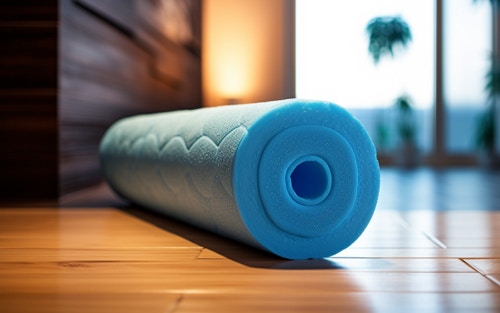
In addition to professional massage therapy, self-massage techniques can offer valuable relief for arthritis patients, allowing them to manage pain and improve mobility at home. These techniques involve the use of tools, heat application, and moderate pressure to alleviate discomfort and enhance joint function.
The subsequent sections will discuss:
- Various tools and devices for self-massage
- The benefits of heat application before self-massage
- The importance of using moderate pressure and proper techniques for effective symptom relief.
Tools and Devices
Self-massage can be performed with your hands or various devices, such as foam rollers, massage balls, or handheld massagers. These tools can help target specific areas of pain and discomfort, providing targeted relief for arthritis symptoms.
Foam rollers, for example, can improve flexibility, reduce stiffness, and relieve pain in affected joints by applying pressure to tight or sore areas. Massage balls can apply gentle pressure to the joints and muscles, providing targeted therapy for arthritis relief. By incorporating these tools into your self-massage routine, you can effectively manage your arthritis symptoms and improve your overall well-being.
Heat Application
Applying heat before self-massage can increase the benefits of the massage by relaxing the muscles and improving circulation. Heat application can be achieved through various methods, such as soaking in warm water, heating pads or hot packs, and warm baths or showers.
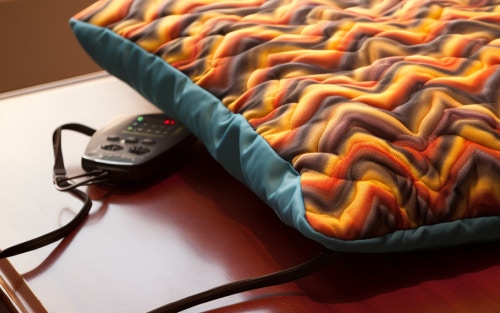
By incorporating heat application into your self-massage routine, you can enhance the effectiveness of the massage by allowing for the loosening of stiff joints, providing relief for achy muscles, and increasing the flexibility of muscles and connective tissue. This can result in a more effective and comfortable self-massage experience for arthritis patients.
Moderate Pressure and Technique Tips
Using moderate pressure and proper techniques during self-massage is crucial to ensure effective symptom relief and avoid causing further pain or inflammation. Moderate pressure is advised for a self-massage to relieve Arthritis, as it activates pressure receptors beneath the skin, reducing pain and stress signals.
When massaging sensitive areas affected by Arthritis, it is important to use moderate pressure and gentle techniques to avoid applying too much pressure or causing any pain. By following these guidelines and listening to your body, you can effectively manage your arthritis symptoms through self-massage and enjoy the benefits of improved joint mobility and reduced pain.
Precautions and Contraindications
As with any treatment, it is important to take precautions and consult with a healthcare professional before starting massage therapy for Arthritis, especially during active inflammation or if there are any contraindications. By consulting with a healthcare professional, you can ensure that massage therapy is a safe and viable option for your specific arthritis condition and any other health concerns you may have.
The subsequent sections will discuss precautions for active inflammation and the importance of consulting with a healthcare professional before initiating a new treatment plan.
Active Inflammation
Avoiding deep pressure on the affected joints during active inflammation is crucial, as it may cause further pain or damage. Inflamed joints are already sensitive and tender, and applying deep pressure can further aggravate the inflammation and potentially worsen the condition.
If you are experiencing active inflammation, it is essential to consult with a healthcare professional before undergoing massage therapy to ensure it is safe and suitable for your specific condition. By taking these precautions, you can protect your joints and avoid causing additional pain or damage during massage therapy.
Consult with a Healthcare Professional
Always consult with a healthcare professional before starting a new treatment plan, as massage therapy may not be suitable for all arthritis patients or may need to be tailored to individual needs. By discussing your specific condition and goals with your healthcare provider, you can ensure that massage therapy is a safe and effective option for your arthritis management and overall well-being.
Summary
In conclusion, massage therapy offers a range of potential benefits for arthritis patients, including pain relief, improved joint mobility, and enhanced quality of life. By understanding the various types of massages, choosing the right massage therapist, incorporating self-massage techniques, and taking necessary precautions, individuals with Arthritis can effectively manage their symptoms and enjoy better overall well-being. After answering, is massage good for Arthritis? Be advised every case is unique and must be treated as such. Remember, it is essential to consult with a healthcare professional before starting any new treatment plan and to listen to your body’s needs and preferences throughout your massage therapy journey.
Frequently Asked Questions
Should arthritic joints be massaged?
Massage therapy is a safe and effective way to relieve symptoms of Arthritis. Studies have shown that it can reduce stiffness, improve the range of motion, and promote blood circulation around affected joints. Massage can also help decrease swelling, reduce muscle tension, and increase flexibility. Before beginning massage therapy, consult with your doctor to ensure it is safe for your particular condition.
Does massage reduce inflammation?
Massage therapy has been shown to reduce inflammation when administered by a professional, as well as improve fluid build-up and circulation. Paragraph 2: It is also suggested that light exercise can be even more effective at reducing inflammation.
Is heat good for Arthritis?
Alternating between heat and cold therapy may help ease arthritis symptoms, as heat increases blood flow while cold constricts blood vessels and helps reduce stiffness and inflammation.
What types of massage are most beneficial for arthritis patients?
People living with Arthritis can benefit from various massage types, such as hot stone, deep tissue, sports massage, and myofascial release.
What precautions should be taken before starting massage therapy for Arthritis?
Before starting massage therapy for Arthritis, consult with a healthcare professional to ensure it is appropriate and avoid massaging actively inflamed joints.
(706) 521-5290
Disclaimer: This blog provides general information and discussions about health and related subjects. The information and other content provided in this blog, website, or in any linked materials are not intended and should not be considered or used as a substitute for medical advice, diagnosis, or treatment. This blog does not constitute the practice of any medical, nursing, or other professional healthcare advice, diagnosis, or treatment. We cannot diagnose conditions, provide second opinions, or make specific treatment recommendations through this blog or website.
If you or any other person has a medical concern, you should consult with your healthcare provider or seek other professional medical treatment immediately. Never disregard professional medical advice or delay in seeking it because of something that you have read on this blog, website, or in any linked materials. If you are experiencing a medical emergency, please call 911 or call for emergency medical help on the nearest telephone immediately.